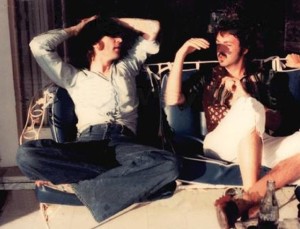 Well, as it turns out, they sat in the Lennons’ living room and watched Saturday Night Live! Imagine their surprise when SNL producer Lorne Michaels appeared on their TV screen, announcing an offer to pay the Beatles $3,000 to come together and perform three songs on his show! He held up a check and said, “NBC has authorized me to offer you a certified check for $3,000….you can divide it anyway you want. If you want to give Ringo less, that’s up to you.” What a commentary on the creative pecking order, albeit at poor Ringo’s expense!
Well, as it turns out, they sat in the Lennons’ living room and watched Saturday Night Live! Imagine their surprise when SNL producer Lorne Michaels appeared on their TV screen, announcing an offer to pay the Beatles $3,000 to come together and perform three songs on his show! He held up a check and said, “NBC has authorized me to offer you a certified check for $3,000….you can divide it anyway you want. If you want to give Ringo less, that’s up to you.” What a commentary on the creative pecking order, albeit at poor Ringo’s expense!
John later told David Sheff, author of the book All We Are Saying, “He [Paul] was visiting us at our place in the Dakota. We were watching it [SNL] and almost went down to the studio, just as a gag. We nearly got into a cab, but we were actually too tired.”
WHAT? Two healthy guys in their mid-thirties, too tired? From what…smoking too much weed? How dare they deprive the world of what would have been the biggest event in rock history! Oh, well. Yoko would have tagged along and ruined the whole thing anyway.
A month later, Michaels again tried to lure the Beatles, this time with a sum of $3,200 and an offer by NBC to pay for their hotel accommodations! He asked SNL announcer Don Pardo to provide more details. Here’s the hilarious transcript:
First of all, the lads from Liverpool will be picked up by a radio-dispatched Checker cab that will whisk them to the Cross Town Motor Inn, located in the heart of New York’s fashionable garment district. Once there, they will check in, in the recently renovated lobby; and then it’s off to their rooms via round-the-clock elevator service. They’ll be treated like royalty, as pitchers of ice water are hand-delivered to their rooms, and they can drink that water from glasses sanitized for their convenience. Oops — Ringo spilled a little something on his jacket? No problem — not with prompt forty-eight-hour dry cleaning service! ‘In by Tuesday, out by Thursday.’ And let’s just put a shine on those shoes, too, with a free shoe shine cloth. And, Lorne, since the Beatles will be staying in separate rooms, the four Mop Tops can speak to each other as much as they want because there is no charge for room-to-room calls. And, after a hard day’s night, the Beatles can sleep as late as they like with a leisurely checkout time of 10 A.M. That’s the Cross Town Motor Inn, a hotel tradition, hosting New York’s visitors since 1971. Yeah, yeah, yeah! Back to you Lorne!
Okay, pretty funny, but the huge sums offered by other industry moguls were nothing to scoff at. Three months before Lorne Michaels’ offer, promoter Bill Sargent tried to bait the Beatles with a payment of $50 million. And later in the year, Sid Bernstein, the man who promoted the Beatles’ early U.S. tours, offered a staggering $230 million for them to perform a one-time-only charity concert. The four turned it down, although sources say Paul considered it.
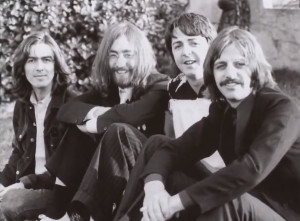 The closest thing to a Beatles reunion took place on May 19, 1979, when Paul, George, and Ringo jammed at the wedding of Eric Clapton and Pattie Boyd (George’s ex-wife). They performed shaky, alcohol-laced renditions of “Get Back,” “Sgt. Pepper’s Lonely Hearts Club Band,” and “Lawdy Miss Clawdy.” But where was John? He and Clapton had been tight in the early ’70s, when the guitarist performed with John at his Live Peace in Toronto concert. Did Eric and Pattie forget to send John an invitation? Did Yoko receive it and toss it in the trash? In Peter Doggett’s book, You Never Give Me Your Money, Clapton said, “John later phoned me to say that he would have been there too if he had known about it.” Sadly, all hopes for a Beatles reunion were abandoned on December 8, 1980, when John was assassinated as he entered his apartment.
The closest thing to a Beatles reunion took place on May 19, 1979, when Paul, George, and Ringo jammed at the wedding of Eric Clapton and Pattie Boyd (George’s ex-wife). They performed shaky, alcohol-laced renditions of “Get Back,” “Sgt. Pepper’s Lonely Hearts Club Band,” and “Lawdy Miss Clawdy.” But where was John? He and Clapton had been tight in the early ’70s, when the guitarist performed with John at his Live Peace in Toronto concert. Did Eric and Pattie forget to send John an invitation? Did Yoko receive it and toss it in the trash? In Peter Doggett’s book, You Never Give Me Your Money, Clapton said, “John later phoned me to say that he would have been there too if he had known about it.” Sadly, all hopes for a Beatles reunion were abandoned on December 8, 1980, when John was assassinated as he entered his apartment.
When the Beatles played their impromptu “concert” on the rooftop of the Apple Records building during the “Let It Be” recording sessions in January 1969, little did anyone know it would be the final live performance of the greatest and most influential band in history. It was the world’s finest free concert. Priceless.
Here’s Lorne Michaels, offering The Beatles the BIG check, on April 24, 1976:
© Dana Spiardi, April 24, 2013
]]>
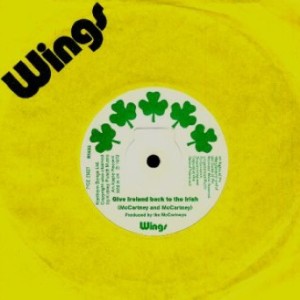 Paul’s record company EMI reluctantly agreed to let him and his band Wings record and release the protest song, but warned it would be banned. Which, of course, it was — by the BBC, Radio Luxembourg and the U.K.’s Independent Television Authority. But despite its lack of airplay it managed to chart – reaching the #1 spot in Ireland and Spain, #16 in the U.K., and #21 in the U.S. Like John and Yoko, whose “Two Virgins” album was banned for full frontal nudity on its cover, Paul now had his own censored piece of work, thus qualifying him for membership in the rock-n-roll rabble-rousers society (at least for a short time).
Paul’s record company EMI reluctantly agreed to let him and his band Wings record and release the protest song, but warned it would be banned. Which, of course, it was — by the BBC, Radio Luxembourg and the U.K.’s Independent Television Authority. But despite its lack of airplay it managed to chart – reaching the #1 spot in Ireland and Spain, #16 in the U.K., and #21 in the U.S. Like John and Yoko, whose “Two Virgins” album was banned for full frontal nudity on its cover, Paul now had his own censored piece of work, thus qualifying him for membership in the rock-n-roll rabble-rousers society (at least for a short time).
Most people aren’t aware that John had also recorded two songs in response to Britain’s brutal treatment of Ireland: “Sunday Bloody Sunday” and “The Luck of the Irish,” both featured on his June 1972 LP “Some Time in New York City.”
John said he was inspired to write “The Luck of the Irish” after taking part in a 1971 London protest march in support of Ireland. Said John, “I’m a quarter Irish or half Irish or something, and long, long before the trouble started, I told Yoko that’s where we’re going to retire, and I took her to Ireland. We went around Ireland a bit and we stayed in Ireland and we had a sort of second honeymoon there. So I was completely involved in Ireland.”
Many critics lauded John’s empathetic song supporting the Emerald Isle – in the ‘Pool they told us the story / how the English divided the land / of the pain and the death and the glory / and the poets of old Ireland – but bemoaned Yoko’s contribution to the lyrics, which included mentions of shamrocks, rainbows and leprechauns, and a hope for the “world [to] be one big Blarney stone.”
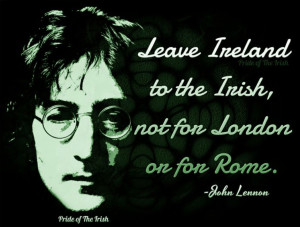 In response to Bloody Sunday, John participated in a protest outside the New York office of Britain’s national airline, BOAC. Soon after, he wrote “Sunday Bloody Sunday.” Commenting on his motivation to pen the song, he said: “Most other people express themselves by shouting or playing football at the weekend. But me, here I am in New York and I hear about the 13 [sic] people shot dead in Ireland, and I react immediately. And being what I am, I react in four-to-the-bar with a guitar break in the middle.”
In response to Bloody Sunday, John participated in a protest outside the New York office of Britain’s national airline, BOAC. Soon after, he wrote “Sunday Bloody Sunday.” Commenting on his motivation to pen the song, he said: “Most other people express themselves by shouting or playing football at the weekend. But me, here I am in New York and I hear about the 13 [sic] people shot dead in Ireland, and I react immediately. And being what I am, I react in four-to-the-bar with a guitar break in the middle.”
Interestingly, John recorded his song during the same month that Paul recorded “Give Ireland Back to the Irish.” But Paul beat John to the punch, releasing his single four months before Lennon’s song appeared on his “Some Time in New York City” album. The two were still in a period of backbiting and competition following the Beatles’ 1970 breakup, so John no doubt got his Irish up over Paul’s single, which was more timely and garnered much attention.
John’s original family surname was O’Lennain, the Gaelic word for love. But unlike most people who boast of even the most minuscule amount of Irish blood flowing through their veins, John rarely made a great deal of fanfare about his roots.
For the record, Paul is three-quarters Irish and George Harrison was one-quarter Irish. Poor Ringo hasn’t a drop of Irish blood, but we love him all the same.
Here’s John’s “Sunday Bloody Sunday”:
And “The Luck of the Irish,” minus Yoko’s singing:
And Paul’s “Give Ireland Back to the Irish”:
© Dana Spiardi, March 17, 2013
]]>
to measure record sales.
No song’s the winner,
no song ever fails.
Imagine all releases
treasured equally….
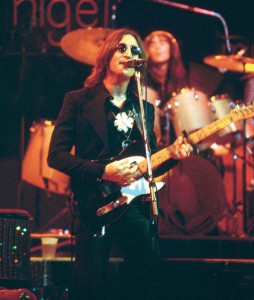 Imagine the most defining song of John Lennon’s career NOT reaching the number one spot on the Billboard charts when it was released in October 1971. I wonder if you can. Surprisingly, John’s iconic peace anthem “Imagine” actually peaked at number three, which just goes to prove that chart position does not a legendary song make. John’s only solo career single to hit the number one spot during his lifetime was “Whatever Gets You Through the Night,” which topped the U.S. charts in November 1974.
Imagine the most defining song of John Lennon’s career NOT reaching the number one spot on the Billboard charts when it was released in October 1971. I wonder if you can. Surprisingly, John’s iconic peace anthem “Imagine” actually peaked at number three, which just goes to prove that chart position does not a legendary song make. John’s only solo career single to hit the number one spot during his lifetime was “Whatever Gets You Through the Night,” which topped the U.S. charts in November 1974.
As was his method, media junkie John often copped song titles and ideas from tabloids and boob tube babble. One late night, while channel surfing in his New York City apartment, he stumbled upon a program featuring the black evangelist Reverend Ike, who said unto the TV audience: “Let me tell you guys, it doesn’t matter, it’s whatever gets you through the night.” Bingo. The rest came naturally.
In the summer of 1974, John called on his friends – all top session players of the day – to seal the song on vinyl. They included guitarist Jesse Ed Davis and drummer Jim Keltner. John’s pal from the Beatles’ early Hamburg days, Klaus Voormann, played bass, and his British brother-in-therapy Elton John provided backing vocals and piano. But it’s the song’s blast of sax, provided by Texan shit-kicker Bobby Keys, that gave the tune its rollicking signature sound.
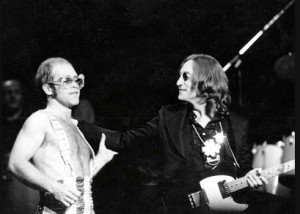 Recorded for the “Walls and Bridges” LP, Lennon had little faith that the song would make an impact as a single. But Elton felt otherwise. He made a wager: if the song hit number one, John would have to promise to perform at Elton’s Thanksgiving concert at Madison Square Garden on November 28, 1974. On November 10, the song rocketed to number one in the U.S., and John made good on his promise. To the audience’s great surprise, a very nervous former Beatle took the stage with Elton to sing “Whatever Gets You Through the Night,” “Lucy in the Sky with Diamonds,” and “I Saw Her Standing There.”
Recorded for the “Walls and Bridges” LP, Lennon had little faith that the song would make an impact as a single. But Elton felt otherwise. He made a wager: if the song hit number one, John would have to promise to perform at Elton’s Thanksgiving concert at Madison Square Garden on November 28, 1974. On November 10, the song rocketed to number one in the U.S., and John made good on his promise. To the audience’s great surprise, a very nervous former Beatle took the stage with Elton to sing “Whatever Gets You Through the Night,” “Lucy in the Sky with Diamonds,” and “I Saw Her Standing There.”
Who would have ever imagined that it would be John’s final concert performance?
Out the blue or out of sight,
S’alright, John. S’alright.
Watch this fabulous video of the song. It’s comprised of animations of John’s whimsical drawings.
By Dana Spiardi, Oct 9, 2014
]]>Right on, Jules. Even though I shed a tear each and every December 8th – the date of John’s murder in 1980 – this year I’d like to present an upbeat memorial to the man whose music changed my life. How about a little story about his influence on the city of Prague, the capital of the Czech Republic, where the Lennon Wall – Lennonova Zeď – stands as a symbol of freedom.
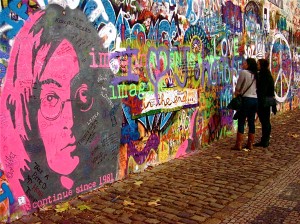 John was a voice of peace all over the world – even in the Communist-controlled countries of the former Soviet Union. The Commies tried their best to halt the influx of Western pop culture and fashion, but no Iron Curtain or Berlin Wall could keep out the Beatles. All the kids knew of them. And if you had black market connections, you could get your hands on one or two of their records — or at least a bootleg made from smuggled-in originals.
John was a voice of peace all over the world – even in the Communist-controlled countries of the former Soviet Union. The Commies tried their best to halt the influx of Western pop culture and fashion, but no Iron Curtain or Berlin Wall could keep out the Beatles. All the kids knew of them. And if you had black market connections, you could get your hands on one or two of their records — or at least a bootleg made from smuggled-in originals.
Enterprising music lovers routinely duplicated records using a device known as a roentgenizdat to press sound grooves onto the acetates of discarded x-ray plates. Imagine placing a film of Uncle Vladimir’s spleen on the turntable and rocking to “Abbey Road.”
The news of John Lennon’s murder in December 1980 sent shock waves around the world. In Prague, young people paid their respects by establishing an “unofficial” memorial to the fallen Beatle. They singled out a large wall at Grand Priory Square, and began covering it with beautiful graffiti images of John and his lyrics. The more rebellious of the lot – inspired by his message of “Power to the People” – also used the wall as a canvas on which to scrawl their grievances, particularly against Gustáv Husák, who ruled the country (then known as Czechoslovakia) – from 1969 through 1991.
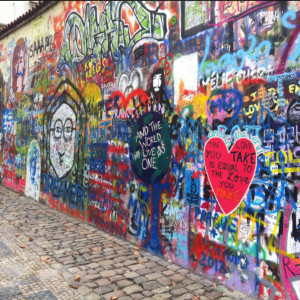 Husák succeeded President Alexander Dubček, whose liberal policies brought about the famous Prague Spring of 1968 — a period of relative freedom that effectively ended when Moscow rolled its tanks into the city’s Wenceslas Square as a clampdown on any burgeoning democracy. With Dubček soon banished, Husák reversed his short-lived policies and purged the country’s Communist Party of all its liberal members. The Czechs’ brief taste of freedom was gone.
Husák succeeded President Alexander Dubček, whose liberal policies brought about the famous Prague Spring of 1968 — a period of relative freedom that effectively ended when Moscow rolled its tanks into the city’s Wenceslas Square as a clampdown on any burgeoning democracy. With Dubček soon banished, Husák reversed his short-lived policies and purged the country’s Communist Party of all its liberal members. The Czechs’ brief taste of freedom was gone.
Flash forward 20 years: young men and women were increasingly aggravated by Husák’s growing conservatism. In the fall of 1988 they took to the Lennon Wall, airing their complaints in the form of anti-government graffiti. This and other acts of protest led to a huge clash between the police and hundreds of students on the city’s treasured Charles Bridge. The protestors called their activist ideology “Lennonism.” Czech authorities denounced the rabble rousers as crackpots, alcoholics, and proponents of Western capitalism. That episode was one of several that gave way to the Velvet Revolution, which culminated in the end of communist rule in November 1989.
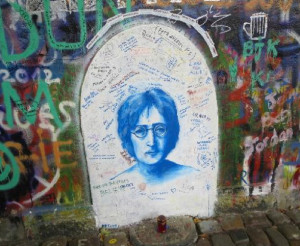 But despite its role in socio-political discourse, the wall never lost its original purpose: as a memorial to John’s life, music and messages. Czech authorities occasionally painted over the images, hoping to end the graffiti. But their efforts were useless. By the next day it was filled up again with Lennonisms. I had a chance to see what is perhaps the most powerful and famous graffiti portrait of John (the photo in the header above) when I first discovered the wall in 1991. Today, the memorial is a big tourist attraction – one that wasn’t listed in any of the city guides when I first set foot there.
But despite its role in socio-political discourse, the wall never lost its original purpose: as a memorial to John’s life, music and messages. Czech authorities occasionally painted over the images, hoping to end the graffiti. But their efforts were useless. By the next day it was filled up again with Lennonisms. I had a chance to see what is perhaps the most powerful and famous graffiti portrait of John (the photo in the header above) when I first discovered the wall in 1991. Today, the memorial is a big tourist attraction – one that wasn’t listed in any of the city guides when I first set foot there.
John would have loved Prague. I often think about how thrilled he would have been to know that people living in an oppressed society bucked authority by artistically promoting his messages of peace and love, in pursuit of freedom. “Give peace a chance?” Yes, they certainly did.
© Dana Spiardi, Dec 8, 2013
Header photo by Kevin McCann
]]>
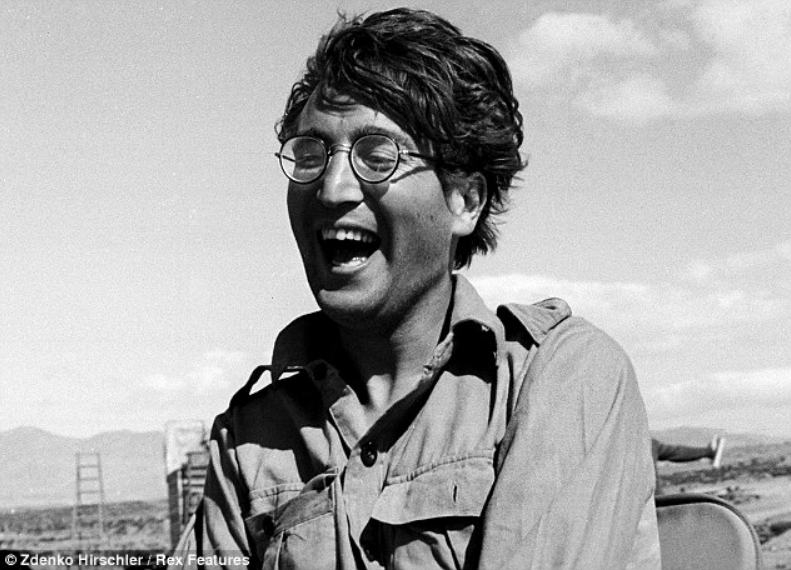 John’s fans may have been surprised to see him wearing glasses in this offbeat little film. Little did they know at the time that his vision had been poor since childhood. His Aunt Mimi constantly nagged him to wear his glasses – which, of course, he hated. Teddy Boys and Gene Vincent wanna-bes didn’t wear glasses! He stumbled around half-blind without specs until he finally began wearing contact lenses during the height of Beatlemania.
John’s fans may have been surprised to see him wearing glasses in this offbeat little film. Little did they know at the time that his vision had been poor since childhood. His Aunt Mimi constantly nagged him to wear his glasses – which, of course, he hated. Teddy Boys and Gene Vincent wanna-bes didn’t wear glasses! He stumbled around half-blind without specs until he finally began wearing contact lenses during the height of Beatlemania.
Imagine his dismay when he learned that his Private Gripweed role called for him to don the owlish wire-framed glasses once issued by Britain’s National Health system. Well, he ended up embracing his new look and wore the specs from that point on – thus creating a signature style that was quickly copied by the youth of the day. Nobody would have been caught dead wearing wire-rimmed granny glasses before John made them fashionable. I remember the day I went from plastic cat-eyes to wire rectangles. Sure, I loathed wearing glasses as a kid, but at least with cool Lennon frames I could feel more like the hippy-dippy flower child I longed to be. And then along came Janis Joplin with those huge round wire specs, to seal the style for chicks. Ah, kaleidoscope eyes behind those lenses.
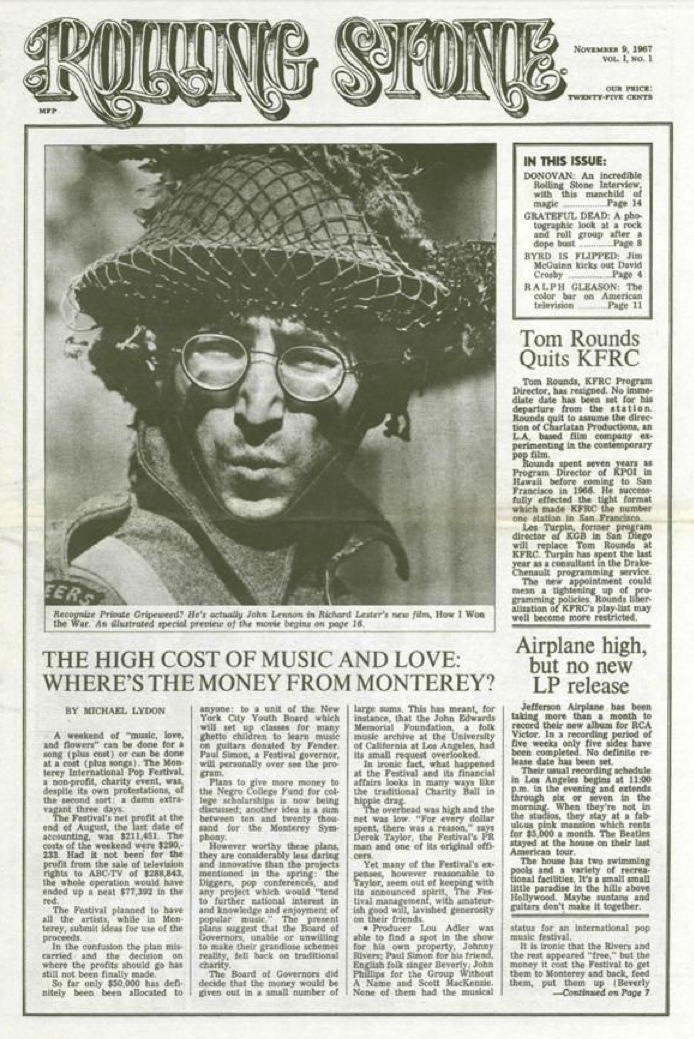 As for the movie? It was a critical and commercial disappointment. And what of John’s acting? Well, inspired, of course…but it really didn’t matter. The project gave him a break from the pressure of touring and recording with the Beatles. But, most importantly, a masterpiece emerged from the experience: during down-time on the set in Almeria, Spain, John composed what I consider his most magnificent song: “Strawberry Fields Forever.”
As for the movie? It was a critical and commercial disappointment. And what of John’s acting? Well, inspired, of course…but it really didn’t matter. The project gave him a break from the pressure of touring and recording with the Beatles. But, most importantly, a masterpiece emerged from the experience: during down-time on the set in Almeria, Spain, John composed what I consider his most magnificent song: “Strawberry Fields Forever.”
An iconic photo of bespectacled John in his combat helmet graced the cover of the very first issue of Rolling Stone magazine, on November 9, 1967 – several weeks after the film’s release.
Here’s a look at John’s scenes in “How I Won the War.”
© Dana Spiardi, October 9, 2014
]]>